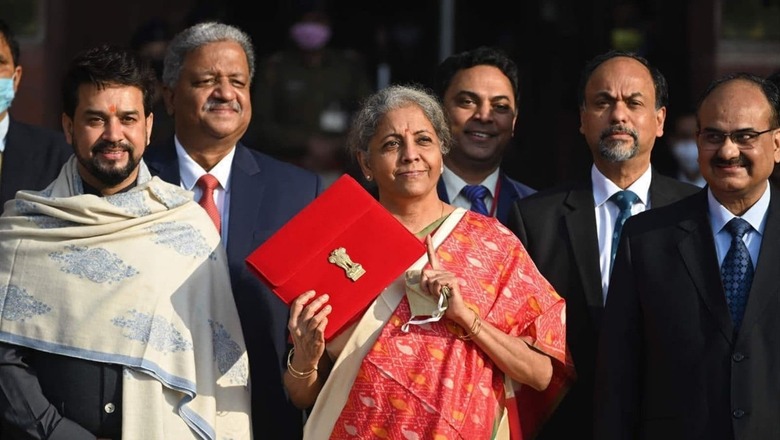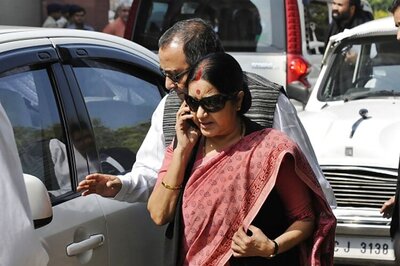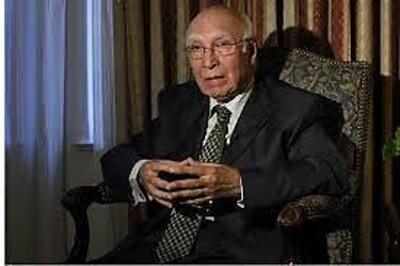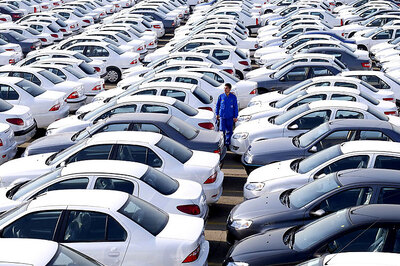
views
The economic growth of India is often compared with its blow hot-blow cold neighbour China. In 1960, the GDP of the Indian economy at $148 billion was way ahead of Chinese GDP at $128 billion. Instructively, India stayed ahead of China till 1977, and it was only in 1978, the year China opened to the world, that its GDP at $296.6 billion inched ahead of Indian GDP at $296.3 billion. But China-India or ‘Chindia’ comparison ended there.
The next four decades have belonged to China. It catapulted from subsistence-level agriculture economy to manufacturing- and export-led behemoth. Its metamorphosis from $296.6 billion GDP in 1978 to $8 trillion in 2012 before galloping to $18 trillion in 2021, growing consistently around 9.5 percent per annum, has no parallel. In last nine years, China has added $10 trillion to the Chinese economy.
And what an amazing success story of distributive, equitable and inclusive growth it has been. In four decades, China has done the heavy lifting of taking 850 million people out of poverty. In 1981, 90 per cent of its population was below the international poverty threshold, the latest World Bank data puts it at 1 per cent. The Chinese success story is led by three things: manufacture, export, and infrastructure. Its massive infrastructure push apart from becoming enabler of the growth has also been a growth propeller in its own right.
The dragon has shown the path.
And, it is the time for India’s Finance Minister Nirmala Sitharaman to show that ‘the elephant too can dance’. Budget 2022, therefore, has a lot of expectations riding on it.
Prime Minister Narendra Modi thinks audaciously big. As he prepares the nation for Vision @2047, he should think bigger – catapulting the economy from $3 trillion to $5 trillion by 2025, $10 trillion by 2035 and $25 trillion by 2047 when India celebrates 100 years of independence.
To actualise the dream, the country must consistently achieve double-digit growth, a feat not achieved in past; manufacturing sector must gallop from its measly 17 per cent contribution to GDP with a low 11 per cent employment contribution; exports must grow exponentially; agriculture must transform itself.
To make this happen, India needs a quantum leap in physical, social and digital infrastructure. The Finance Minister must start with removing the bottlenecks and implementation bugs in some of the flagship projects of the government.
Smart City Mission
The Smart Cities Mission, launched in 2015 with an investment of Rs 2,05,018 crore, aims to transform 100 selected cities by driving growth, making them bankable and more liveable, improving mobility, ushering in best practices like solid waste management, bringing in smart e-governance solutions and unleashing the power of technology.
It is a timely mission to correct the urban grid lock and mess that exists in cities and towns stuck in the muddle due to haphazard and unplanned evolution. The mission ticks all the right boxes – special purpose vehicle-led institutional structure, area-based and city-based development, PPP approach, retrofitting, redevelopment and greenfield projects. These are citizen-centric solutions but as hundreds of more cities wait in the wings for their chance, urgent corrective measures are needed for the Mission to deliver. And, these steps have to be taken in terms of timeliness, financing, institutional robustness, project selection, implementation hurdles and project impact.
Swachh Bharat Abhiyan and AMRUT
The Swachh Bharat Abhiyan and the Atal Mission for Rejuvenation and Urban Transformation (AMRUT) have been two transformative programmes. While the key priority area of AMRUT (1.0) was water supply followed by sewerage, Swachh Bharat Abhiyan (1.0) focused on eliminating open defecation and promoting solid waste management. They also aimed at biggest behavioural change initiatives attempted anywhere in the world. The achievements of these two programmes are notable. Nonetheless, the country today is nowhere close to the actualisation of the century old sanitation dream of Mahatma Gandhi.
In 2021, the government launched a more ambitious Swachh (2.0) and AMRUT (2.0). While former focuses on the goal to “make the cities completely free of garbage”, the later aims at “improving sewage and septic management, making our cities water-safe cities and ensuring that no sewage drains anywhere in our rivers”. Actual performance of Swachh and AMRUT are appreciable, but teething troubles remain on ground to make the gains sustainable. Finance Minister must share a clear strategy to make the gains achieved so far sustainable and provide adequate outlay for both the Missions.
Pradhan Mantri Awas Yojana
The Pradhan Mantri Awas Yojana, both urban and gramin, are working for the target population. The house help at my in-laws’ place received a sanctioned amount under the scheme to convert her kuccha dwelling into a pucca house in her village. But the ambitious goal of “housing for all by 2022” looks unattainable. Budget 2022 must make mid-course correction and provide adequate outlay, implementation strategy and monitoring framework to complete the two flagship programmes by 2024.
Rural Electrification
The rural electrification programme was not launched by the Narendra Modi government, but full credit to it for fast-tracking 100 per cent electrification in all villages. But access to 24X7 quality supply of power has eluded not just villages but even towns and cities. The biggest drain to the sector remains poorly performing and terminally debt-laden distribution sector. It is time for a strategic rethink to herald next-generation reforms, giving primacy to the hard-core reality that one size does not fit all.
Health Infrastructure
Our health infrastructure – at primary, secondary and tertiary level – was in tatters well before the onslaught of COVID-19. Worse, of the total health expenditure equivalent to 5 per cent of the GDP, the contribution of the government is barely 1 per cent with out-of-pocket expenditure of families making up 4 per cent.
Inequity is inbuilt in the system where poorest suffer the most. And, COVID-19 delivered a body blow to this creaking system. What the country needs and what the Finance Minister must provide is a quantum jump in government spending in the health sector, both preventive and curative.
Education
Several aspects of the Indian education system are in deep trouble, but the author wants to focus on school education for children between 3 and 18 years of age. Under the Right to Education Act, free and compulsory education to children between 6 and 14 years of age is a fundamental right, to be ensured by the government. In the last decade, thanks to RTE, there were impressive gains in school enrolment – and schemes like mid-day meal, free cycle to girl students helped with the retention rate.
Sadly, in the last two years since COVID hit us, school closure and remote learning have widened the learning gap, with urban and rural poor being the worst hit. The increase in ‘learning poverty’ has been monumental and the Finance Minister must provide solutions, including a massive outlay for new tools of learning (smartphone, laptop and internet connectivity), for the poor children lest the learning poverty becomes permanent.
Digital Infrastructure
India has taken giant strides in creation of digital infrastructure, so much so that the present generation will not believe that it was barely 27 years ago that VSNL had started its internet service. Today, India has more internet connections than any other country except China. Digital technology has transformed the way we work, where we work. It is changing not only the governance model, but 2022 Assembly elections are proof that technology is even changing electioneering.
But India continues to have a sharp digital divide. Half of India’s population lacks internet access, many more have to do with poor service, with one study claiming that more than 50000 villages are without mobile connectivity. The smartphone penetration in India is substantially lower when compared to the US, China or even Indonesia. India needs to string the whole nation together, including the villages, with high-speed broadband and 100 per cent mobile connectivity through affordable smartphones. The Finance Minister must provide the pathway for the same. The gains for incremental investment are stratospheric and the cost of not investing now is too high. It is time to make a choice.
This is the second article in a two-part series on how Budget 2022 can deliver on infrastructure and growth. You can read the first article here.
The author is an infrastructure expert and President, Advisory Services, BARSYL Limited. The views expressed in this article are those of the author and do not represent the stand of this publication or the author’s company.
Read all the Latest Opinions here




















Comments
0 comment